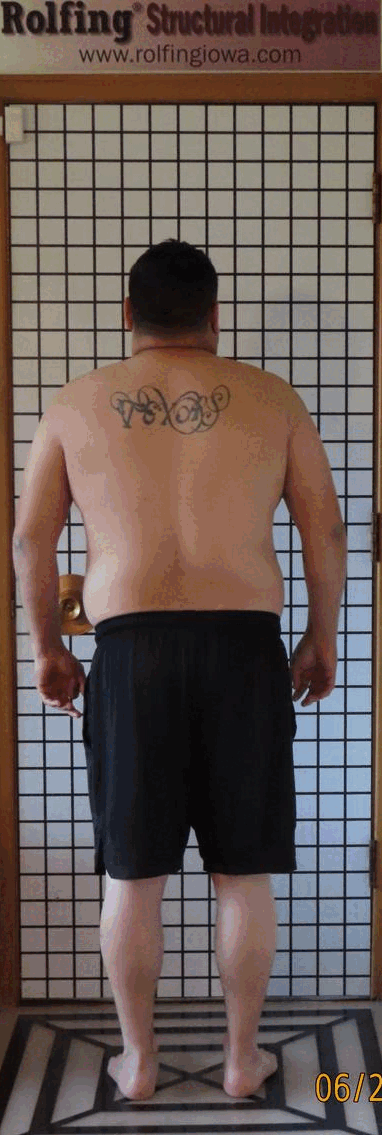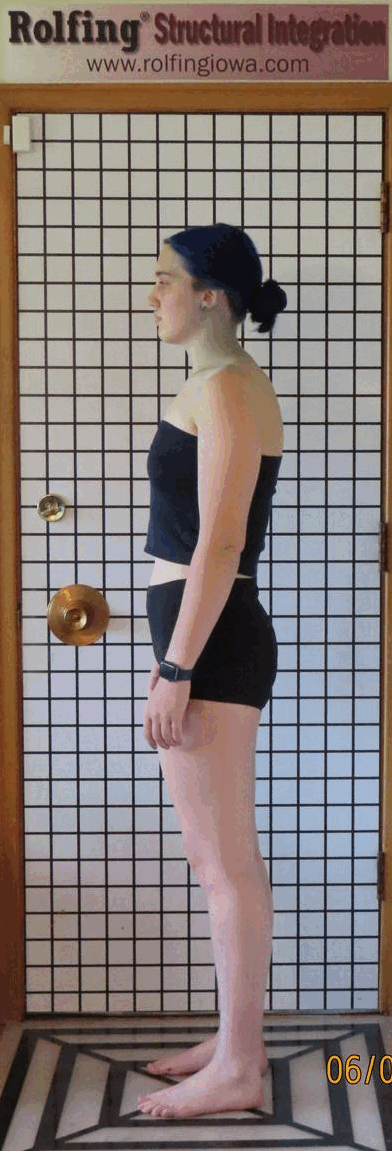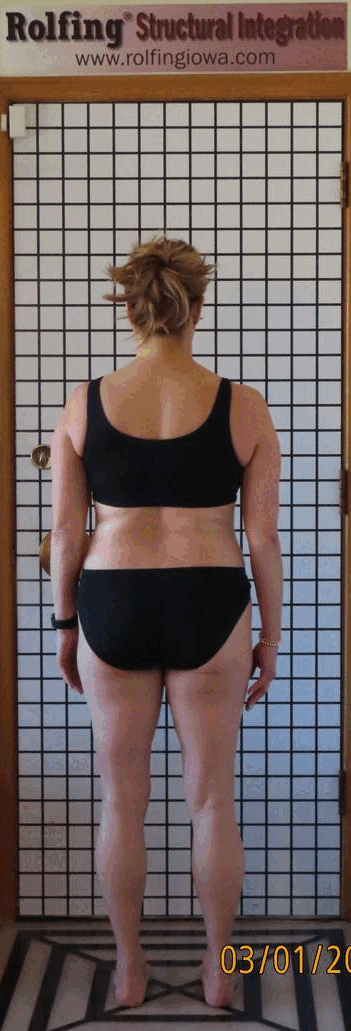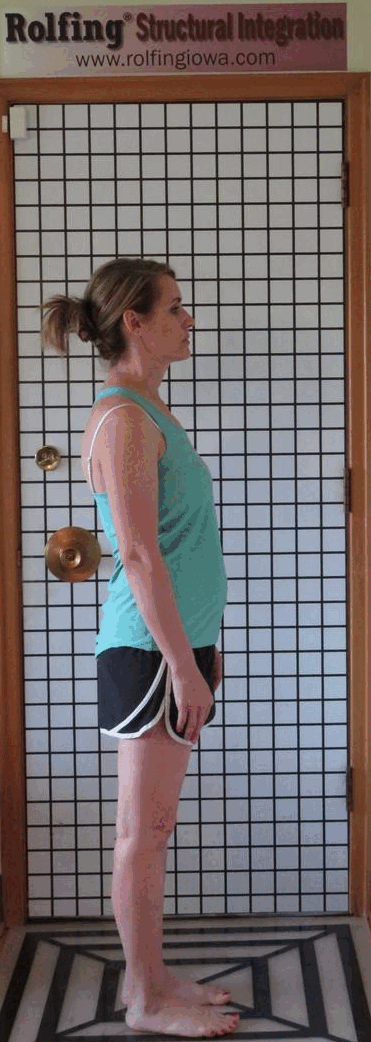Blog
Creating Lift
 Very nice before and after image from a single session. In the after picture my client is counteracting gravity’s influence and creates lift coming up and out of her hips. Implied but not seen the lumbar spine is too far anterior and part of the challenge is to shift the lumbar spine more posteriorly which is no easy task. Engagement of the core muscles is helpful in this regard to shifting the lumbar spine back. From a lateral line perspective my client looks good since she is counterbalancing her structure effectively. If one could magically bring her lumbar spine back it would throw her lateral line off completely. To move the lumbar spine back takes time and the slower pace of doing that allows everything above to shift to accommodate a new refined lateral line.
Very nice before and after image from a single session. In the after picture my client is counteracting gravity’s influence and creates lift coming up and out of her hips. Implied but not seen the lumbar spine is too far anterior and part of the challenge is to shift the lumbar spine more posteriorly which is no easy task. Engagement of the core muscles is helpful in this regard to shifting the lumbar spine back. From a lateral line perspective my client looks good since she is counterbalancing her structure effectively. If one could magically bring her lumbar spine back it would throw her lateral line off completely. To move the lumbar spine back takes time and the slower pace of doing that allows everything above to shift to accommodate a new refined lateral line.
Migraine Headaches

Significant shift shown here in these before and after images from a single session. My client has been experiencing migraine headaches throughout most of his life. There is a dramatic shift in weight left to right going up the length of his body. His head moves toward the centerline of his body and his shoulder girdles and pelvis are much more horizontal. His posterior neck lengthens dramatically, and his eyes are on the horizon which is the best orientation most generally for a head position. Rolfing helps clients pay attention to what they might be doing habitually with their body that is not helping their structure and what that feels like so they learn to self-correct old habits of posture going forward and can keep the changes over time.
Outstanding First Session
 In this before and after picture from my clients first session in the Rolfing series she shifts from a more posterior tilt to a more natural anterior tilt in the pelvis. That shift moves up her torso and enables her shoulder girdle to release more anteriorly. Her posterior neck lengthens and her head rests better on her shoulder girdle. We will be taking out the flexion of the thigh soon in a later session as we quickly transition to the lower legs and feet which are the basis of support for a person’s structure. Integration is the focus of the Rolfing process which translates into feeling and moving better in your body!
In this before and after picture from my clients first session in the Rolfing series she shifts from a more posterior tilt to a more natural anterior tilt in the pelvis. That shift moves up her torso and enables her shoulder girdle to release more anteriorly. Her posterior neck lengthens and her head rests better on her shoulder girdle. We will be taking out the flexion of the thigh soon in a later session as we quickly transition to the lower legs and feet which are the basis of support for a person’s structure. Integration is the focus of the Rolfing process which translates into feeling and moving better in your body!
Working with the Cervical Spine
 Favorable shift in this before and after picture from a single session. My client had complicated and detailed cervical spine surgery, so I worked very carefully into that area. Creating space in his upper shoulder girdle to allow space for his head to extend and rest more comfortably on his shoulder girdle giving more ease to his structure which translated into a better lateral line presentation as his chest expands and torso lengthens.
Favorable shift in this before and after picture from a single session. My client had complicated and detailed cervical spine surgery, so I worked very carefully into that area. Creating space in his upper shoulder girdle to allow space for his head to extend and rest more comfortably on his shoulder girdle giving more ease to his structure which translated into a better lateral line presentation as his chest expands and torso lengthens.
Basis of Support
 A nice shift in this before and after picture from a single session. My client’s legs move to a better position supporting his structure more constructively. His left lower leg and foot had more lateral rotation and after the session is more congruently in line so that his weight is more evenly distributed throughout a much larger area of the plantar fascia of the foot and would be able to bear weight more efficiently. His right lower leg and foot have a different profile than the left with less lateral rotation and his issue is more in the medial arch of the foot, knee area and adductor compartment of that leg. After the session, his pelvis is more supported with both legs under him in a better alignment. There is more to do in the integration process of course and in the Rolfing® paradigm we are working with the basis of support and moving up the body.
A nice shift in this before and after picture from a single session. My client’s legs move to a better position supporting his structure more constructively. His left lower leg and foot had more lateral rotation and after the session is more congruently in line so that his weight is more evenly distributed throughout a much larger area of the plantar fascia of the foot and would be able to bear weight more efficiently. His right lower leg and foot have a different profile than the left with less lateral rotation and his issue is more in the medial arch of the foot, knee area and adductor compartment of that leg. After the session, his pelvis is more supported with both legs under him in a better alignment. There is more to do in the integration process of course and in the Rolfing® paradigm we are working with the basis of support and moving up the body.
Moving Toward Integration
 A Before and after image of my client showing improvement in the low back area in a single session. My client is in very good shape and in the after picture she is showing a more horizontal pelvis and gains length on both sides of her body as her weight shifts from left to right and her weight is more evenly balanced through both legs. Most people that come to me for Rolfing have several areas where they are experiencing issues in their body, and we work at balancing and integrating their structure. The way I go about it is going to vary person by person although I use principles that can be similar. Coming here to Rolfing Iowa is a good idea for people who want to move with more fluidity and have less pain in the areas that are giving them trouble.
A Before and after image of my client showing improvement in the low back area in a single session. My client is in very good shape and in the after picture she is showing a more horizontal pelvis and gains length on both sides of her body as her weight shifts from left to right and her weight is more evenly balanced through both legs. Most people that come to me for Rolfing have several areas where they are experiencing issues in their body, and we work at balancing and integrating their structure. The way I go about it is going to vary person by person although I use principles that can be similar. Coming here to Rolfing Iowa is a good idea for people who want to move with more fluidity and have less pain in the areas that are giving them trouble.
Balancing Weight in Structure
 A nice shift in structure in this before and after picture from a single session. My client has been seeing a variety of practitioners using different therapies and she decided she wanted to try Rolfing since her progress had been limited before coming to me. My client was having trouble with walking and leading an active lifestyle like she had been in the past. Her walking is now improving, and she is experiencing less pain in the areas that were debilitating. We have been working on getting her right leg to bear weight and extend more into the ground.
A nice shift in structure in this before and after picture from a single session. My client has been seeing a variety of practitioners using different therapies and she decided she wanted to try Rolfing since her progress had been limited before coming to me. My client was having trouble with walking and leading an active lifestyle like she had been in the past. Her walking is now improving, and she is experiencing less pain in the areas that were debilitating. We have been working on getting her right leg to bear weight and extend more into the ground.
As the pain has lessened, we have been making progress in that area. Because of all the issues in the right leg, you can see how she has off loaded her weight to her left side and in the after picture, more weight is allowed to transfer to her right side. There is more even weight distribution through her legs and her right leg is less laterally rotated with a more horizontal pelvis. Her shoulder girdle is more even and the distance on both sides of her body from the top of the iliac crests to the axillae more similar.
Pain and Structure

Nice shift in my client in this before and after picture from a single session. My client has been experiencing significant pain in the last few years and had some surgical procedures without success to remedy her pain. She remained in pain after this session even though she showed a good shift in her structure. In the end a torn hamstring muscle was completely missed in her prior diagnosis. This session was done prior to the torn hamstring muscle being revealed in a later MRI. This brings me to the point of pain and structure. In the after picture her alignment is significantly better and in past blogs, I point out what is better as I could in this one but it is beside the point, my client can only focus on her pain.
Traditionally the Rolfing series was designed for taking clients through a multi session protocol where their pain issues often resolved even though it was never the focus of a particular session. Most clients come to me about pain issues and in all the variety ways they present. Rolfing differentiates itself from the various other modalities that exist in this regard-it changes people’s structure and often the pain aspects of why they came are diminished or relieved. Spot work is necessary for some people before they are comfortable enough to receive the series and I can and will do that as necessary and although Rolfing was not designed for spot work it is still all things considered very good at it much of the time.
Moving toward Alignment
 Great before and after picture here from a single session with my client. The process of establishing more of a lateral line is very clear in this example. Gravity is a powerful force and is either supporting you or working against you. We are attempting to let gravity flow through your structure to allow for a more energetic person. Her flexion in her thigh is greatly reduced which allows her pelvis and abdomen to move posteriorly and that movement continues up her body and lessens the rounding in her shoulder girdle. We are looking to make incremental changes in a client’s structure, and this is a significant shift so paying attention to what is different and how it feels different is part of the process to be able to keep the better alignment.
Great before and after picture here from a single session with my client. The process of establishing more of a lateral line is very clear in this example. Gravity is a powerful force and is either supporting you or working against you. We are attempting to let gravity flow through your structure to allow for a more energetic person. Her flexion in her thigh is greatly reduced which allows her pelvis and abdomen to move posteriorly and that movement continues up her body and lessens the rounding in her shoulder girdle. We are looking to make incremental changes in a client’s structure, and this is a significant shift so paying attention to what is different and how it feels different is part of the process to be able to keep the better alignment.



